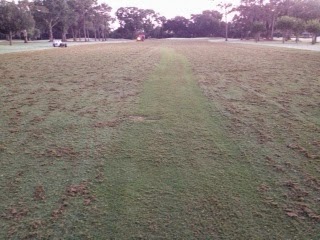Billy Fuller Donald Ross work experience:
Alamance
Country Club, Burlington, NC (see below);
Highlands
Country Club, Highlands, NC (I have been working with this club since 1996,
both consulting and design work); most recent work has included new 10th green
complex, extension to #11 green, and new putting and chipping green
complex;
Hinsdale
Golf Club, Clarendon Hills, IL (western suburb of Chicago)…BFGD established a
Restoration / Preservation Master Plan for this Donald Ross design in
2005-2006;
Augusta
Country Club, Augusta, GA (While working at Augusta National I played most of
my golf at Augusta C.C. After leaving ANGC I worked with Cupp in a
Ross renovation of Augusta C.C.)
Rosedale
Golf Club in Toronto, Canada
East
Lake Golf Club, Atlanta, GA (When Rees Jones was hired to restore the golf
course, I was hired as consultant to watch over the project with the golf
course superintendent)
Charlotte
Country Club, Charlotte, NC (consultant)
Palm
Beach Country Club, Palm Beach, FL (consultant)
Jekyll
Island Golf Club, Georgia (consultant)
Benvenue
Country Club, Rocky Mount, NC (consultant)
Hyde
Park Golf & C.C., Cincinnati, OH (consultant)
Belle
Meade, Nashville, TN (consultant)
Shelby
Golf Course, Nashville, TN (First Tee program)
Pine
Needles Golf Club, Southern Pines, NC (I was assistant golf course
superintendent at Pine Needles in 1973. I spent months studying Donald
Ross’s history while living and working there, including Mid Pines and
Pinehurst #2. I lived in a garage apartment on #2 and spent many hours
after work walking the course and studying archives.
Alamance
C.C. was the last set of plans Donald Ross drew. He died before the
course was constructed. A golf pro then took Ross’s plans, cleared the
routing per his plan, then put his own strategy into the golf course. The
Club eventually discovered the plans and hired Cupp and I to put Ross’s
strategy into the course.
Chicago,
IL (While master planning and renovating Hinsdale Golf Club in Chicago ( Ross
design), I had the good fortune of studying numerous Donald Ross courses,
including Beverly Country Club, Evanston Golf Club, Old Elm Club and Oak Park
Country Club)
I
am a huge fan of Golden Era Period (late 1800’s to 1950). I have worked
on as many Seth Raynor courses as Donald Ross, and a few William “Billy”
Bell and Perry Maxwell. I have played Chicago Golf Club (C.B. MacDonald
and Seth Raynor) several times as well as Shore Acres (Raynor). I
consulted extensively at Country Club of Charleston, SC (Seth Raynor) and
Yeaman’s Hall Golf Club (Seth Raynor).
The
key to any Golden Era designer is understanding his style. They all had
great strategic design and taught us modern designers how to design strong and
proper strategy from tee to green.




































.jpg)







.jpg)
